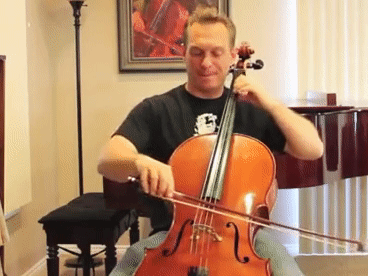Slick As A Whistle!
Time to test your muscle memory by complicating the task. Take the same motion developed in video 1 and video 2 and start using the bow. The more weight you add to the exercise the smaller the motion becomes and the more likely you are to lock up and create a vibrato that sounds like a spasm and has only one speed — on or off. We are going to great lengths to help you create a motion that you can control and vary with the music. So for now keep the weight minimal and rather than the big cello tone you are used to, go for a false, whistle-tone by not pushing the string all the way to the fingerboard.
Now more than ever it is important to double check your checklist:
- Elbow stays put — don’t let the elbow move up or down as the rotation occurs
- Rotation is centered — rock back towards your ear as much as you rock forward below your nose
- Straight EWP — keep a straight line from the tip of your elbow to the pinkie knuckle (Elbow – Wrist – Pinkie)
- Use the back not the wrist — your wrist should not twist or rotate, it acts only as an extension of the forearm. Originate the motion using back muscles (lats).

With this exercise we are going for control. Can you maintain the correct motion and control how much weight you apply to the string with your left hand? Just press the string down far enough to indent it slightly but not so far as to press the string all the way to the fingerboard. In the next exercise we will need to use the control you develop in this exercise to create a true vibrato. Once we press the string all the way to fingerboard it becomes much more difficult to visually check the amount of weight and much easier to overdo it and lockup.
Pro Tip
Vibrato is one of the most unique characteristics of your sound. Take some time on YouTube and do a comparative analysis of vibrato. Yo-Yo Ma has a very different vibrato than does Rostropovich. Both Jacqueline du Pré and Lynn Harrell had vibratos beloved by many cellists. My personal vibrato hero is cellist Pierre Fournier. Comment on your vibrato heros and why!
Once you feel you have mastered the whistle-tone vibrato exercise with your 2nd finger on the D-string, try transferring the same exercise to all 4 strings and all 4 fingers. If you can control the motion and the weight using all 4 fingers on all 4 strings you definitely ready for video lesson number 4.
HAPPY PRACTICING CELLISTS!
